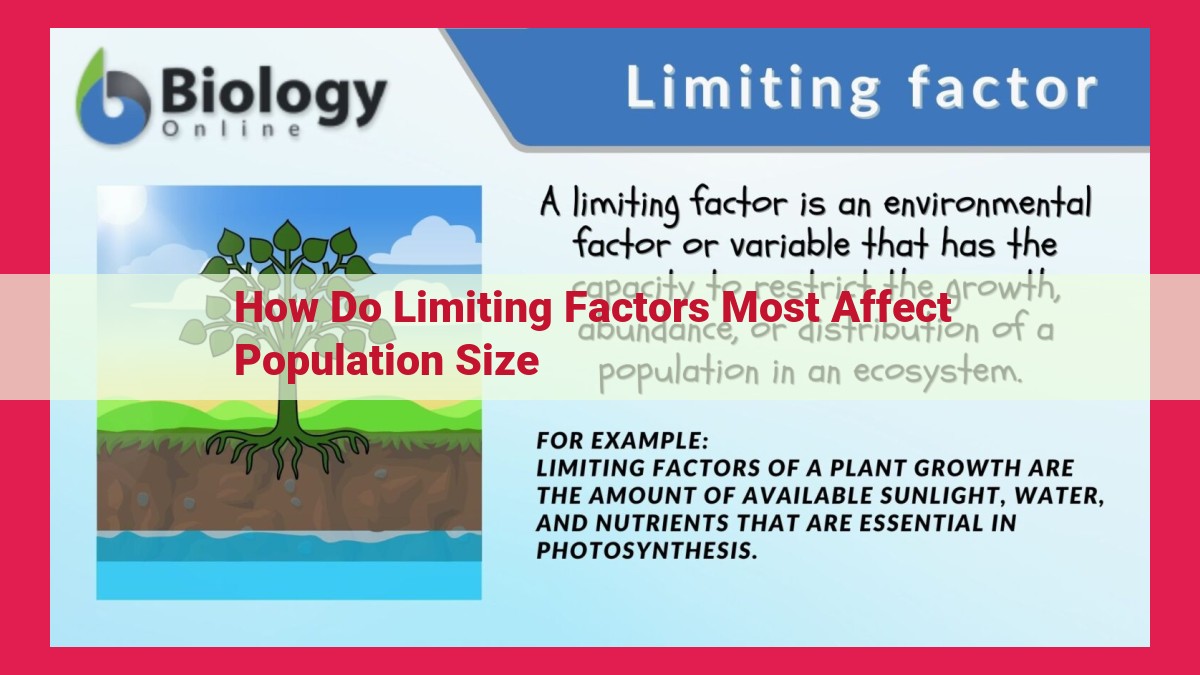Limiting Factors: Key Determinants Of Population Size And Ecosystem Health For Seo

Limiting factors, such as resource availability, competition, predation, disease, parasitism, pollution, and climate change, profoundly influence population size. They restrict the growth and survival of individuals, leading to population fluctuations and determining the carrying capacity of an environment. Understanding these factors is crucial for population dynamics, conservation efforts, and the overall health and sustainability of ecosystems.
Population Size and Limiting Factors: Navigating the Delicate Balance of Nature
In the intricate tapestry of life, the size of a population holds profound significance, influencing the stability and resilience of ecosystems. Every living organism occupies a specific niche within its environment, competing with others for resources essential to its survival. However, the availability of these resources is not inexhaustible, and it is within this interplay that we discover the concept of limiting factors.
Limiting factors are aspects of the environment that restrict the size of a population. They act as invisible barriers, preventing populations from growing beyond certain thresholds. Understanding the nature of these factors is crucial for deciphering population dynamics and implementing effective conservation strategies.
Foremost among these limiting factors is resource availability. Food, water, shelter, and breeding sites are all essential for the well-being of any species. When resources become scarce, populations are forced to adjust, either through competition or migration.
Competition occurs when two or more species rely on the same resources. This competition can take various forms, such as interspecific competition between different species and intraspecific competition within a single species.
Predation is another potent limiting factor, as predators play a vital role in regulating prey populations. Predators cull the weak and sick individuals, reducing competition within the prey species and ultimately maintaining a healthy ecosystem balance.
Disease and parasitism can also decimate populations, particularly when they become epidemic. Pathogens, carried by vectors such as mosquitoes or ticks, can spread rapidly through a population, causing widespread mortality or weakening individuals until they succumb to other hazards.
Today, pollution and climate change are emerging as significant limiting factors for many species. Air, water, and soil pollution can poison wildlife, impair their ability to reproduce, or disrupt their natural behaviors. Climate change, on the other hand, poses a more complex challenge, altering habitats, disrupting food chains, and driving species to the brink of extinction.
Understanding and addressing limiting factors is paramount for sustainable population management. It empowers us to devise conservation strategies that mitigate threats, protect habitats, and ensure the long-term persistence of both individual species and entire ecosystems.
Limiting Factors and Population Size: Understanding the Forces that Shape Nature
Resource Availability:
Every species occupies a specific niche within an ecosystem, unique to its resource requirements. The carrying capacity of an environment represents the maximum population size it can support based on the available resources. When resources such as food, water, and shelter become scarce, population growth slows or even reverses.
Competition:
Interspecific competition arises when different species compete for the same limited resources. This can lead to the more dominant species outcompeting the weaker ones. Within a species, intraspecific competition occurs, which can regulate population size through increased mortality and reduced reproductive success.
Predation:
Predation plays a crucial role in population control, as predators feed on prey species. This interaction creates food chains and trophic levels, with higher-level predators keeping prey populations in check. Changes in predator-prey dynamics can significantly impact ecosystem stability.
Disease:
Pathogens, such as viruses and bacteria, can cause diseases that spread through populations. Disease outbreaks can decimate populations, especially if they lack immunity or are exposed to novel pathogens. Vectors, such as mosquitoes, play a vital role in disease transmission.
Parasitism:
Parasites establish complex relationships with their hosts. Some parasites, like tapeworms, can harm their hosts, while others, like gut bacteria, may benefit them. Commensalism describes a relationship where one species benefits without harming the other, while mutualism is a mutually beneficial relationship.
Pollution and Climate Change:
Pollution in various forms, including air, water, soil, and noise, can adversely affect animal behavior, human health, and ecosystem services. Climate change, driven by greenhouse gas emissions, leads to sea level rise, extreme weather events, and habitat loss, with significant consequences for population size and distribution.
By understanding these limiting factors, scientists and conservationists can develop strategies to manage populations sustainably, protect biodiversity, and mitigate the impacts of environmental change.